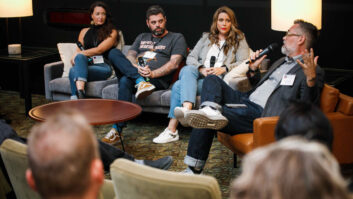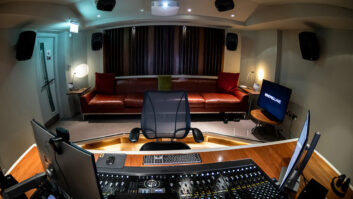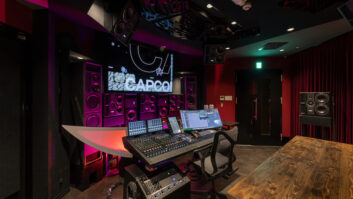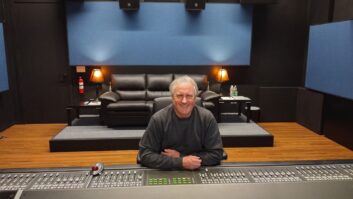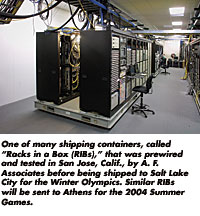
Digital television has enjoyed a long gestation period from its bold
and brash introduction a decade ago. For a myriad reasons, the
availability of HDTV was delayed and on-air launch dates slipped
forward. But consumer demand for receivers created by cornerstone
productions such as The Tonight Show With Jay Leno, The
Grammy Awards and The West Wing is rapidly accelerating. And
with adramatically increased level of sports programming, hi-def is
here to stay. Though it took a while to reach the public, broadcasters
have not been idle. The key to any successful technical installation is
a properly conceived and executed technical infrastructure.
Infrastructure is one of those oft-used expressions that can be hard
to define, but for our purposes, in the media production industry,
let’s say it is the means by which data is transferred and distributed
throughout a facility. The advent of digital technology has certainly
broadened any manageable definition. Now, instead of relatively
conventional balanced/unbalanced audio cables to transfer analog
signals from place to place, we’ve added the complexity of real-time or
on-demand streaming of digitized audio and video data. Data rates
require more than just twisted-pair copper, so co-ax, fiber and other
means of signal distribution are becoming commonplace. Also, with
transfer of audio and video via Ethernet-based networked topologies,
CAT5/6 and related nomenclatures are becoming more and more a part of
our everyday vocabulary.
Furthermore, with the broadcast industry poised to offer — if
not already embracing — standard/high-definition TV production,
distribution and transmission, there is a pressing need to acquire,
process and transfer ever-increasing amounts of high-bandwidth data
streams. Fortunately, there now exists a new breed of systems
integrators for whom this lexicography is familiar jargon —
companies that specialize in analyzing the needs of a broadcast or post
facility and turning it into a practical reality, one that will remain
viable for the plant’s projected life.
According to Scott Griffin, VP of engineering at The System Group
(New Jersey), “A primary question to be put to the client is,
‘Green field or facility upgrade?’ It is an important
difference and one that affects the reality of data infrastructures,
because retaining legacy equipment and standards will [impact] what new
platforms can be considered. It’s also critical to know what the
broadcast facility’s programming needs will be, and whether those needs
change dramatically during a work day. It therefore comes down to an
interdependence between media flow and work flow. We identify areas
where file transfers between servers and high-capacity storage systems
can take the place of real-time streams, and we analyze areas of the
operation where file retrieval and manipulation models can replace
real-time stream processing and mixing. If the station will be handling
a combination of live production and repackaged materials from a server
or similar delivery system, then we need to devise an infrastructure
that can handle the capture, manipulation and delivery of the
appropriate range of material.
“In essence, we determine whether the transfer system is
file-based — accessing a file and then delivering it to where it
might be needed — or stream-based, where we need to deliver
digital audio and video continuously,” Griffin adds. “If a
file-based system is appropriate for the task, what are the computer
platforms being used, and what are the file formats? We then select
products that offer the best user interface and functionality, and also
make a determination about whether a targeted manufacturer is going to
be around to support the products for a reasonable amount of
time!”

The system integrator will analyze media requirements more closely
to accurately determine delivery bandwidth. “A facility planning,
let’s say, 30 user seats with bandwidth-intensive processing sessions
dependent upon a central server will narrow the vendor choices because
of the required bandwidth across the network,” he explains.
“We’re always looking for cost-effective solutions to our
clients’ objectives, but we are relatively conservative in our product
selection. If we haven’t observed first-hand that a given platform has
addressed a given requirement in a working environment, then we’ll
visit facilities where a vendor or user group has successfully
addressed that feature to see what is available. We develop a series of
signal flow models that determine the high-level requirements —
how to get the media from component ‘A’ to ‘B,’
and so on — as well as individual operations’ work flows. Each
edit suite, for example, will have its own storage and delivery
requirements, as well as inflow/delivery of media based on the desired
operator toolset. Finally, within each operations suite, we’ll work
with our client to illustrate the operations work space and identify
the support equipment that will be required.”
Recent TSG projects include a new multimedia facility for PBS
affiliate WVIZ-TV, Cleveland; upgrades for MTV Networks (including a
new backup to Disaster Recovery Master Control Systems); station
consolidation for Tribune-owned WXIN and WTTV, Indianapolis; Morgan
Stanley’s new East Coast — headquartered broadcast facility in
Purchase, N.Y.; a new Broadcast Operations Center for CNBC’s financial
news operation in Englewood, N.J.; and Fox News’ street-side studio in
midtown Manhattan.
AUDIO DISTRIBUTION
Once the basic infrastructure is determined, Griffin says, “We
can develop the operator management scheme and move on to the execution
phase. Basically, we now become general contractors for the project and
work closely with the client’s production team and engineering team,
plus their architect and general contractor. The key to any successful
design is project planning — the sequencing and implementation of
each phase.”
In terms of networking, Griffin offers that the primary
consideration is flexibility vs. broadcast integrity. “If it is
an on-air facility with little post-production, we need to emphasize
system reliability, which we balance against routing flexibility.
Consider a system based on MADI routing, which might allow any mic to
be accessed in any room in the complex. What happens if one of the
fibers gets pinched? Or you might lose a feed to all the rooms if one
clock source fails. In this case, we need one or more layers of system
redundancy. We look at redundant power supplies, redundant node
controllers [PC network interface cards], redundant disc controllers
and multiple paths we can use to route signals. But if the design calls
for a series of production environments, we can provide a means of
swapping out vital elements. We do not need a high level of
redundancy.”
Of critical importance to any infrastructure scheme is how to get
signals from one location to another, either in real time via routers
and dedicated highways, or by utilizing a real-time or packet-switched
network topology. For dedicated highways, the choice is often between
conventional balanced/unbalanced copper cabling and co-ax or fiber
interconnects. “Copper is often a very cost-effective,
non-complex way of taking care of the situation,” Griffin offers.
“For networking, we typically have to combine GigE Ethernet and
FireWire interconnect schemes at the desktop, with Fibre Channel, ATM
and/or SCSI for server and data-storage platforms, especially when
linear, uncompressed files are being moved around. The determining
factor is Quality of Service and how the use patterns will stress the
systems. From discussions with the broadcast client, we develop a
statistical model that is based on 30 to 50-percent utilization and
make sure that we can deliver the required bandwidths without
interruption. But it’s often an educated guess: While we can anticipate
the delivery needs, in real-world applications, we cannot always model
the entire system for worst-case maximum capacity usage due to
financial realities.”
Recent TSG audio facility designs have incorporated MADI, TDIF,
Dolby E and Dolby Digital, and audio over IP platforms; tape and
disk-based storage elements also have been included. “The line
between IT and audio transport and storage has been blurry for a long
time,” Griffin says, “but some of the newer products
available today present interesting applications and integration
challenges.”
At Seattle-based Doyle Technology Consultants, the firm’s director
of engineering, John Hartwell, stresses the importance of determining
the type of delivery system being considered by the facility owners.
“We need to analyze the number of channels, system bandwidths,
distances and wiring topologies,” he says. “If the final
audio product is stereo audio, we can develop an AES3-format
infrastructure. With multiple sources and multitrack wiring, we look at
both AES3- and MADI-based infrastructures using fiber and copper for
nonstreaming systems. But multichannel audio is becoming the delivery
format for broadcasters — even more so in Europe — and so
we need to accommodate 5.1-channel capacities. We prefer to carry audio
as discrete channels, but if bandwidth is restricted, we will consider
data compression of some sort. Dolby E seems to have a lot of the hooks
we require and reduces the bandwidth by a factor of four. Up to eight
audio channels can be carried over a conventional 2-channel AES3-format
highway and/or recorded onto a conventional digital audio track that
handles AES signals.”
SYNCHRONOUS, EMBEDDED AUDIO WITHIN SDI VIDEO
And 5.1-channel surround sound requires another infrastructure
scheme for the companion metadata. “Because a broadcaster needs
to come out of the PCM world and enter the Dolby Digital or AC3-encoded
world for transmission,” Hartwell stresses, “we have to
consider what happens to the important metadata during the translation
process.” Doyle Technology Consultants, in partnership with
Wohler Technology, is developing a VMC/Visual Monitor and Control
System for this critical stage. “There is a lot of information
carried within the Dolby E bitstream that needs to be passed on to the
consumer to control; for example, dialog levels in set-top AC3
decoders,” Hartwell continues. “Also, the Dolby E bitstream
might be carrying multiple-language versions of the same program
material. Within master control, the operator needs to be able to
extract the appropriate audio and add other elements. And we are also
looking at asset management using metadata. While many of these
applications might not be in use currently, we need to consider future
developments.”
For networking of digitized audio and video, Hartwell considers,
“We use what works! Full-bandwidth digital audio belongs on AES
and MADI connections using copper or fiber via a nonswitched network.
Data-compressed audio can be carried over a network connection,
although we don’t normally recommend such schemes for real-time
delivery. Ethernet-based networks using conventional PCs and interface
cards are okay for connecting workstations via a public network, but
TCP/IP can be very slow and liable to interruptions. We can deliver
files that are between five and 10-times real time using networks, but
we have had few requests from broadcasters for real-time delivery. For
our post facility clients, including Lucasfilm and Pixar, we specify
real-time transfer over an appropriate network, because we can control
bandwidth and access to highways. A dedicated DS3 network will carry 45
megabits a second.”
A. F. Associates is a leading systems integrator that has been
involved in a number of design and construction projects, including
American Production Services, NBC Burbank’s The Tonight Show With
Jay Leno (one of the first live network shows to be broadcast
regularly in high-definition format), the Staples Center in Los
Angeles, Madison Square Garden, National Mobile Television, Action
Sports and Entertainment Network, Comcast Sports Network and a mobile
truck for Core Digital. The firm is also handling design and
fabrication of modular studio systems that will be packed into
containers and shipped to Greece for NBC’s coverage of the upcoming
Summer Olympic Games. Director of technology Lowell Moulton emphasizes
the use of synchronously embedded audio within SDI video bitstreams as
a way of reducing the complexity of a facility’s infrastructure, as
well as saving weight, for example, in mobile trucks. “Such
vehicles have an all-up weight limit of 80,000 pounds,” Moulton
confides. “Anything that can save weight — including, for
example, disk-based recorders and audio/video over Ethernet — can
be a major design factor.”
NMT’s HD2 hi-def truck required a number of I/O cables for each
video machine. “Most video and audio signals were on single
unidirectional cables,” Moulton recalls, “which means that
many connections must be run to provide inputs, outputs and control
signals to each device. Signal formats such as embedded audio in SDI
interfaces, MADI and SMPTE 324M [a 12-channel AES-like protocol over
co-ax] help reduce cable count by putting many audio channels on a
single cable. In the future, the quantity, weight, volume and cost of
cable in these trucks may be substantially reduced when all video,
audio and control signals are multiplexed onto a single, high-bandwidth
bi-directional cable such as CAT5e UTP and optical fiber. Weight,
volume and cost are critical factors to truck operators.”
RELIABLE DATA NETWORKS FOR DIGITIZED AUDIO AND VIDEO
For the NBC 2004 Athens Olympics, the network had specified two
Calrec Alpha 100 and two Zeta 100 digital consoles. “We are using
AES3 digital audio interconnects,” Moulton explains, “much
of which is embedded into SDI video. And NBC is well-positioned to
transition their Olympics productions from SDTV to HDTV. The 2004
Athens Olympics is wired with cable and connectors that will pass SMPTE
292M HD-SDI signals. We have measured production samples of each
manufacturer’s coaxial cable, BNC connectors and patch circuits using a
3-gigahertz Hewlett-Packard network analyzer. All components we have
specified will provide excellent group delay across a wide range of
frequencies.
“The Sony DVS 8000 standard-definition video production
switchers [specified for the Olympics] can be easily converted to MVS
8000 HD models just by changing out [various component boards]; all
wiring and control panels remain the same. By 2008, NBC coverage of the
Beijing Summer Olympics should be done completely in HDTV.”
Regarding the use of data networks to deliver digitized audio and
video, Moulton stresses that such topologies can be reliable, so long
as several major design considerations are observed. “If we need
to deliver guaranteed bandwidth for audio over Ethernet, then we use a
packet-switching scheme, such as CobraNet. CAT5 cabling is a lot
cheaper than multichannel audio and, because of its operational
flexibility and use of off-the-shelf components, can be very versatile.
We are also looking at AES47, which involves the delivery of multiple
channels of AES-format digital audio using an ATM [Asynchronous
Transfer Mode] network over single CAT5 cabling. [The format is being
used experimentally in the UK by the BBC to connect between Radio 4
studios and to various transmitters.] Unlike IP-based connections, ATM
offers extremely low latency [around 1 ms], supports mixed sample rates
and bit depths simultaneously, and offers a routing and distribution
structure that can be set up as one-to-one or one-to-many.” For
example, the BBC uses 155Mbit/sec ATM highways to carry up to 40
channels of AES3-format 48kHz/24-bit signals in each direction. Two
unused pairs on each CAT5 cable carry a “backup” AES3
stereo signal, plus a dedicated multirate sync reference.
“But we are convinced that Quality of Service must be provided
for broadcast-quality audio and video over IP networks,” Moulton
stresses. “Some of the QoS techniques we’re exploring with
network vendors include over-provisioning private networks, priority
queuing using DiffServ and IntServ [protocols], forward error
correction on low-latency paths and Multi-Protocol Label Switching for
traffic engineering.”
Based in Virginia, HA Design Group recently completed a new facility
for al Hurra, the government-run, Arab-language satellite television
channel for the Iraqi people (formerly known as MTN or Middle East
Television Network). The new channel was launched earlier this year to
compete with al Jazeera and other Arab television networks and,
according to a government statement, “will bring balanced
reporting on international issues to an area of the world where
one-sided coverage is the norm.” The production and broadcast
complex currently houses an on-air studio and control room, 10 edit
suites and a number of news-preparation workstations.
HA Design Group president Willy Halla was formerly with TGS Inc., a
company with a solid track record in DTV and HDTV conversions.
“For the MTN [al Hurra] project, we had looked at a way of using
a shared-resource, software-based plant. As far as the audio consoles
were concerned, there were a lot of potential vendors. In the end, MTN
chose Lawo AG. That decision gave MTN [assignable digital] audio boards
with an extreme amount of power and flexibility — flexibility was
key — and yet they are very easy to use. In fact, the Lawo system
is being introduced to the U.S. market at MTN, which is located in
Virginia.
“A MADI distribution system is used for the digital audio
paths while an Ethernet system handles control of source routing. When
the Lawo software is completed, it will be able to assign any source on
any audio board in the plant to a specific fader on the target control
surface.
“The use of MADI has cut down greatly on the amount of cabling
needed,” Halla says, “thereby reducing installation cost.
Also, instead of using standard metering that would have cost between
$4,000 and $5,000 on the larger audio console, we used a PC/LCD screen
combination that costs $1,500, yet provides greater functionality. The
screens can also be set to display the dynamics section of each
channel.
“Thirdly, the [al Hurra] plant is server-centric,” Halla
stresses. “Everything goes to the server. We have over 100
workstations on the network that are all capable of video and audio
editing, accessing newswires, etc., plus standard office modules. We
are distributing the audio news channels via streaming audio on the
facility’s Intranet, providing access to these via the desktop with the
added ability to record a piece at will.”
Mel Lambert heads up Media&Marketing, a full-service
consulting service for pro audio firms and facilities. Visit him at
www.mel-lambert.com.


